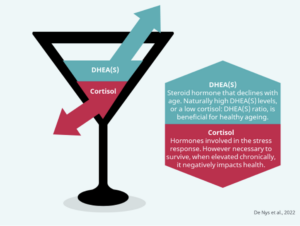Physical activity influences cortisol and DHEA(S) levels in older adults.
Keywords: Exercise, stress, metabolic health
What is the best exercise to combat stress and improve endocrine (hormonal) health for healthy ageing? That is what we want to find out in the PhD project ‘Stress, Healthy Ageing and Physical Exercise (SHAPE)’ at the University of Stirling, Scotland.
The principle of healthy ageing is that all bodily systems interact in symphony to create a balanced and resilient cocktail of health. We conducted a rigorous systematic review to assess whether physical activity could impact a particular physiological cocktail of hormones in the body. This blog provides an overview and key findings from this review.
Physical activity creates the best Cocktail of Healthy Ageing
Let’s call this cocktail ‘the Cocktail of Healthy Ageing’. It’s quite a sober cocktail, as it only has two ingredients: cortisol and a substance called: dehydroepiandrosterone (DHEA). Due to age-related alterations to the hypothalamic-pituitary-adrenal (HPA) axis, the balance of these adrenal hormones may be challenged in ageing.
The first ingredient ‘cortisol‘ is widely known as our stress hormone. When we age, cortisol rises, and the daily cycle of cortisol release gets challenged (we want sharp rises when we wake up, which should gradually decline during the day). Optimal amounts of cortisol can be lifesaving as it is crucial to reducing inflammation, but it negatively impacts health when this hormone is chronically elevated.

The second ingredient is ‘Dehydroepiandrosteron (DHEA)’, and its sulphated form DHEAS. It’s a steroid hormone and gets converted into other hormones that our body needs to develop good health (such as testosterone and oestrogen). DHEA(S) production gradually increases in early life, peaks during our 20s, and steadily decreases into old age.
Generally, a good ratio, lower in cortisol and higher in DHEA(S), is seen in physically active, healthy, and resilient people. Our findings support this statement and show that PA is likely to improve the Healthy Ageing Cocktail by balancing the ingredients towards less cortisol and more DHEA(S).
An active lifestyle may buffer the adverse effects of stress
Apart from physical exercise, physical activity includes activities such as active travel, moving about in the workplace and during chores, etc. These bodily movements all contribute to overall health. They have formed the significant evidence base behind global and national physical activity guidelines (1). The health-enhancing psychological and physical effects of an active lifestyle may extend to this Cocktail of cortisol and DHEA(S). While we only found small associations between regular physical activity and favourable cortisol levels in older adults, we did find convincing evidence that an active lifestyle is associated with higher DHEA(S) levels. These findings agree with the earlier evidence that habitual PA buffers the adverse effects of stress in older men and women by opposing the stress-associated increases in the ratio between cortisol and DHEA (2).
The Best Exercise Modality for Healthy Ageing is not a one-size-fits-all
For an exercise modality to be most effective, it is crucial to maintain a good balance. Essentially, exercise programs seek to produce favourable physiological adaptation effects, contributing to a better Cocktail of Healthy Ageing. An overarching consensus is that the HPA-axis is most impacted when training intensity is higher than 60% of the VO2max (3,4). However, other factors that are also shown to influence hormonal release with exercise include aerobiosis, strength modalities, the time of the day, meal ingestion, and participant characteristics (such as previous training and gender) (5). Our findings show that exercise programs likely improve older adults’ cortisol and DHEA(S) levels. However, like personal taste in cocktails, individually-tailored exercise programs are the most efficient way to improve stress and healthy ageing. To summarise, any exercise modality, whether aerobics, dancing, lifting weights, TheraBand training, combined chair-based exercises, yoga, Qigong or Tai Chi, can improve this Cocktail of Healthy Ageing.

Take home messages
- Maintaining good levels of the adrenal hormones cortisol and DHEA(S) is vital. However, its balance gets challenged in ageing.
- Any regular physical activity program that older adults enjoy could be recommended to influence cortisol and/or DHEA(S) levels.
- An active lifestyle may buffer against the adverse effects of stress.
- Note that most exercise interventions occurred in group settings. Because obviously, what’s a life worth if you don’t enjoy your Cocktail of Healthy Ageing with others!
This article is based on the peer-reviewed paper Physical Activity Influences Cortisol and Dehydroepiandrosterone (Sulfate) Levels in Older Adults: A Systematic Review and Meta-Analysis in the Journal of Aging and Physical Activity (https://doi.org/10.1123/japa.2021-0501)
Len De Nys*1 (corresponding author) @DeNysLenLife, Esther F. Ofosu*1 @Maame_Frema, Gemma C. Ryde*2 @RydeGemma, Jenni Connelly*1 @DrJenniCo, Anna C. Whittaker*1 @brainsnstyle
*1 Faculty of Health Sciences and Sport, University of Stirling, Scotland, UK
*2 Institute of Cardiovascular and Medical Sciences, University of Glasgow, Scotland, UK
Competing interests
We have no conflicts of interest to disclose.
Bibliography
- Bull FC, Al-Ansari SS, Biddle S, Borodulin K, Buman MP, Cardon G, et al. World Health Organization 2020 guidelines on physical activity and sedentary behaviour. Br J Sports Med. 2020 Dec;54(24):1451–1462.
- Heaney JLJ, Carroll D, Phillips AC. Physical activity, life events stress, cortisol, and DHEA: preliminary findings that physical activity may buffer against the negative effects of stress. J Aging Phys Act. 2014 Oct;22(4):465–473.
- Hill EE, Zack E, Battaglini C, Viru M, Viru A, Hackney AC. Exercise and circulating cortisol levels: the intensity threshold effect. J Endocrinol Invest. 2008 Jul;31(7):587–591.
- Caiozzo VJ, Davis JA, Ellis JF, Azus JL, Vandagriff R, Prietto CA, et al. A comparison of gas exchange indices used to detect the anaerobic threshold. J Appl Physiol. 1982 Nov;53(5):1184–1189.
5. Hackney AC. Exercise as a stressor to the human neuroendocrine system. Medicina (Kaunas). 2006;42(10):788–797.